By Aleksandar Milenkoski & Jim Walter
Executive Summary
- Windows Explorer (
explorer.exe) is the top initial living-off-the-land binary (LOLbin) in the chain of LOLbins that threat actors abuse to execute malware through malicious Windows shortcuts (LNK files). - Our mass-analysis of 27510 representative malicious
LNKfiles from VirusTotal revealed Windows Explorer at the top of the list (with 87.2% prevalence), followed bypowershell.exe(7.3%),wscript.exe(4.4%), andrundll32.exe(0.5%).LNKfiles are currently immensely popular among threat actors for malware deployment and persistence. - We have observed intensive advertising of new versions of the mLNK and QuantumBuilder tools for building malicious
LNKfiles in the cybercrime web space since May 2022, with many new features for evasion and stealth. - The mLNK and QuantumBuilder tools enable threat actors to build malicious
LNKfiles in a configurable and convenient manner. Given the popularity ofLNKfiles among threat actors, there is an increasing demand for such tools on the cybercrime market. - The actors behind the QuantumBuilder tool for building malicious
LNKfiles advertise the tool and the value ofLNKfiles to threat actors by claiming that Office macros “are for the most part dead” [as a medium for deploying malware], referring to Microsoft’s recent decision to disable by default Office macro execution in the context of documents that originate from untrusted sources.
Overview
This article discusses Windows shortcuts (LNK files) as a medium to deploy malware and/or establish persistence. In the initial stages of an attack, threat actors are gravitating more towards the use of malicious shortcuts that deploy malware by executing code in the context of so-called living-off-the-land binaries (LOLbins) – legitimate executables that are readily available on Windows systems, such as powershell.exeor mshta.exe – to bypass detection. Threat actors conveniently build malicious LNK files with Windows system capabilities or tools specifically designed for that purpose, and then distribute the files to victims, usually through phishing emails.
Because of these advantages, threat actors are widely abusing shortcuts. Since Microsoft’s announcement that Office applications will by default disable the execution of Office macros in the context of documents that originate from untrusted sources, there has been a significant uptick in malicious actors using alternative mediums for deploying malware, such as malicious Windows Apps and shortcuts (LNK files). We covered malicious Windows Apps in a previous article. In this article, we focus on malicious shortcuts and provide:
- Insights about execution chains that originate from malicious shortcuts. We base our insights on an analysis of 27510 malicious
LNKfile samples from VirusTotal that are representative of the current malicious shortcut landscape. - An overview of active widespread attack campaigns that involve malicious shortcuts and of the dynamics of the cybercrime market for tools that build malicious
LNKfiles. - A summarizing overview of the system activities that take place when a user executes a malicious shortcut. This enables a better and generic understanding of what occurs on a system when a user falls prey to an attack that involves a malicious
LNKfile.
Current Developments in the Malicious Shortcut Threat Scene
Given the popularity of LNK files among threat actors, the dynamics of the cybercrime market for tools has quickly adjusted to serve the demand for tools that build malicious LNK files in a configurable and convenient manner. We spotlight in this section the mLNK and QuantumBuilder tools for building malicious LNK files. We observed that these tools have recently received updates and are currently being intensively advertised in the cybercrime web space.
mLNK
The mLNK tool – released by NativeOne, a tool vendor on the cybercrime scene – is known for its configurability and ease of use. NativeOne released the newest version of the tool, version 4.2, in June 2022. We observed an intensive advertising campaign for the new mLNK version on cybercrime forums and market places.

The new mLNK version brings new features that enable building LNK files that can evade Windows detection mechanisms, such as Microsoft Defender SmartScreen. The public release of mLNK currently sells for a basic price of $100 per month. NativeOne also sells a private release of mLNK 4.2 for $125.00, which bundles more evasion mechanisms than the $25.00 cheaper public release of the tool.
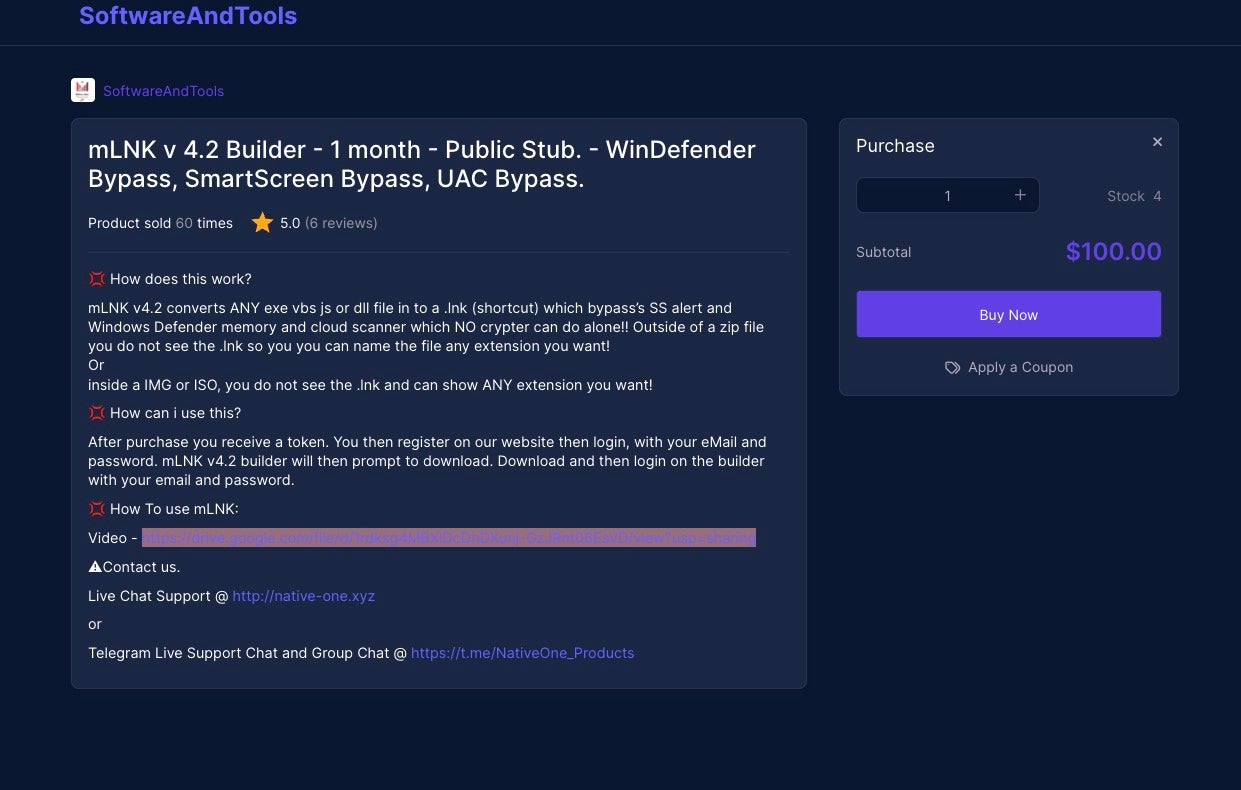
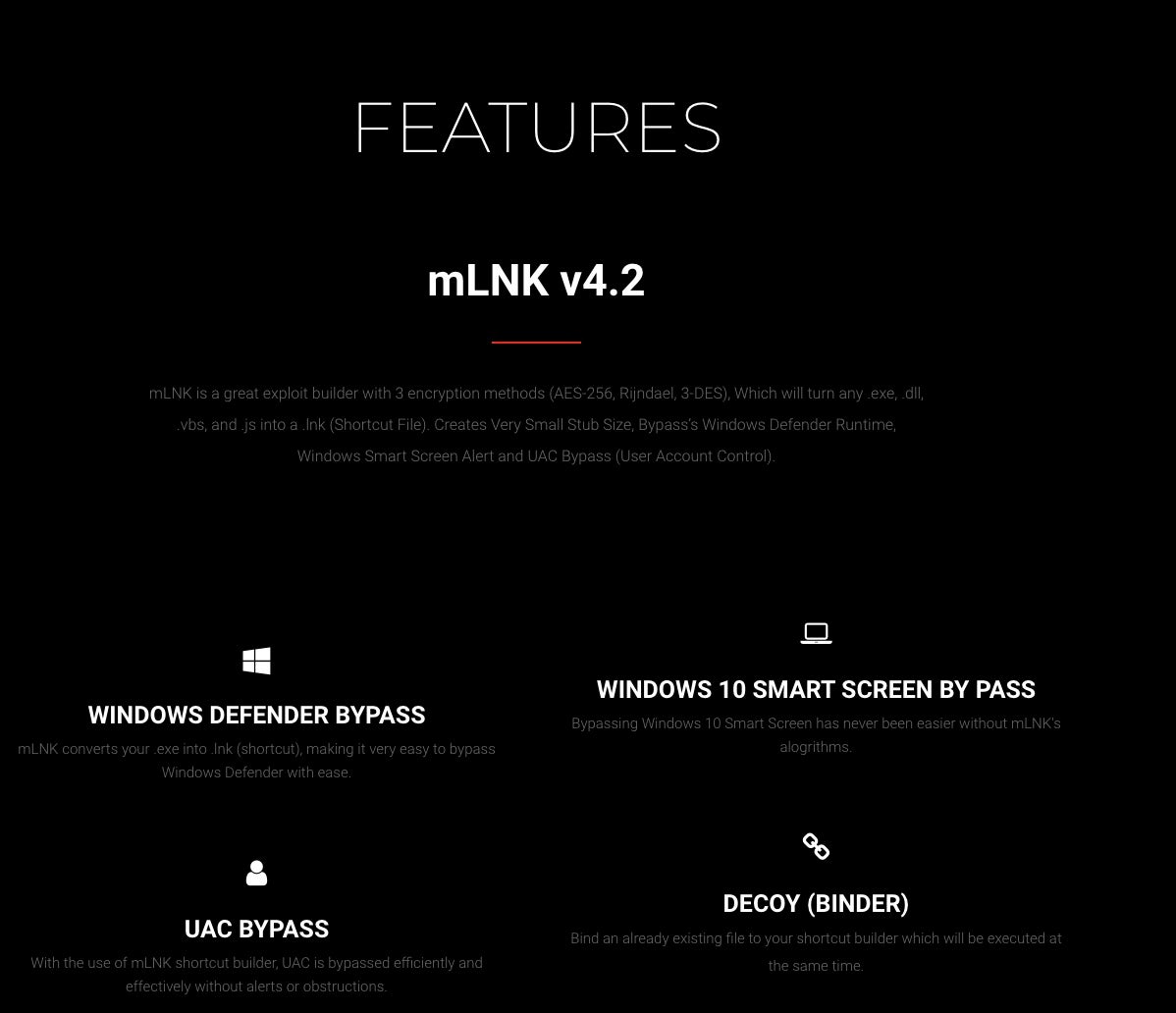
QuantumBuilder
Similar to mLNK, the QuantumBuilder tool is configurable and easy to use, enabling threat actors to conveniently create malicious LNK files. In May 2022, we started observing an advertising campaign for a new QuantumBuilder version in the cybercrime web space, consistent with other reports.
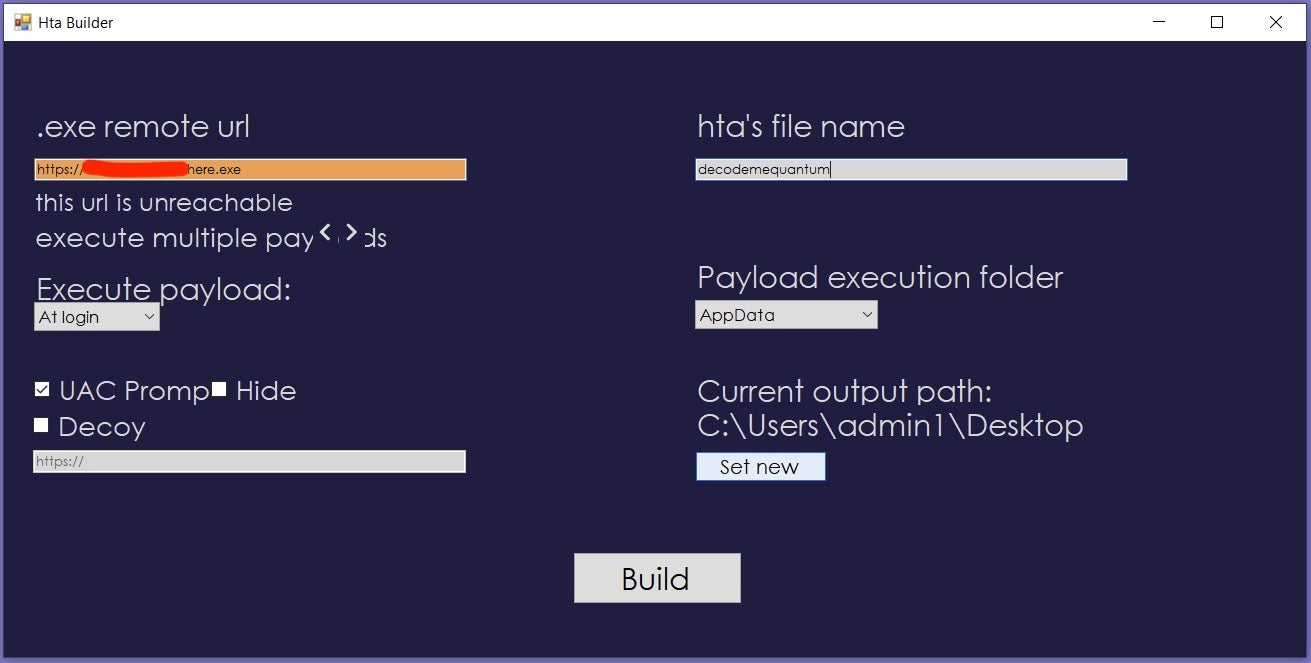
The actors behind the QuantumBuilder tool distinguish between public, VIP, and private users, and sell the tool for a basic price of €189. The following figure depicts the price list of QuantumBuilder as advertised online, including the advantages of becoming a VIP or private QuantumBuilder user.
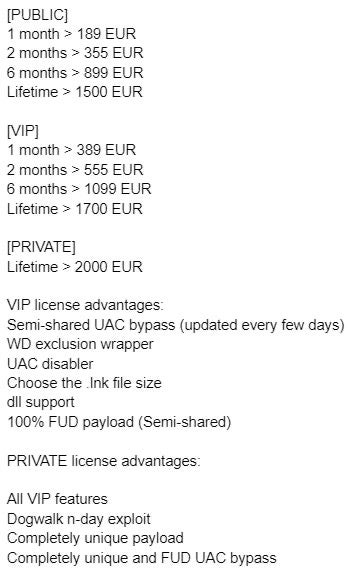
It is interesting to note that the actors behind QuantumBuilder advertise the tool by claiming that Office macros as a medium for deploying malware “are for the most part dead”, referring to Microsoft’s decision to disable by default Office macro execution in the context of documents that originate from untrusted sources.
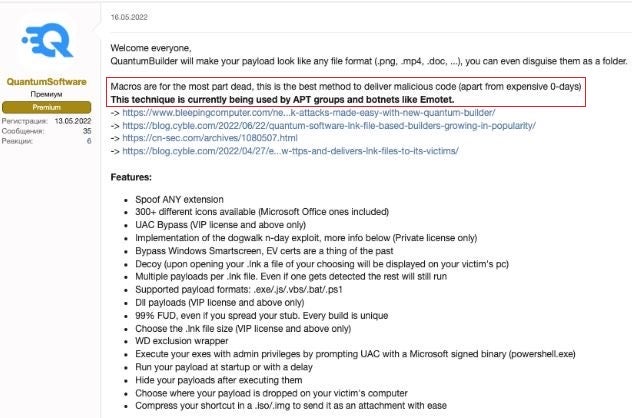
Active Attack Campaigns Leveraging Shortcuts
A number of widespread attack campaigns that involve malicious shortcuts are active at the time of writing this article:
- Threat actors have started intensively distributing the major malware families QBot, Emotet, IcedID, and Bumblebee through
LNKfiles since the second quarter of 2022. These malware families are capable of deploying additional malware on compromised systems, including destructive ransomware. In addition, the Threat Analysis Group (TAG) at Google has observed Exotic Lily, an initial access broker (IAB) for ransomware actors, distributing maliciousLNKfiles to infect systems. - Threat actors have been massively deploying the Raspberry Robin worm on systems through malicious
LNKfiles since September 2021. These attacks specifically involve infected USB media, containing maliciousLNKfiles. - There are several Ukraine-themed attack campaigns as well as attack campaigns specifically targeting Ukrainian systems that are active since the second quarter of 2022. The Armageddon threat group, which the Security Service of Ukraine identifies as a unit of the Federal Security Service of the Russian Federation, has been distributing malicious
LNKfiles through targeted phishing emails. The maliciousLNKfiles deploy the GammaLoad.PS1_v2 malware on compromised systems. There are also other Ukraine-themed maliciousLNKfiles currently in circulation. In addition, the GlowSand attack campaign includes maliciousLNKfiles that download payloads from attacker-controlled endpoints that respond only to requests from systems with Ukrainian IP addresses.
How Threat Actors Are Abusing Shortcuts
In this section, we characterize malicious shortcuts by analyzing the filesystem path to the shortcut target and the command line arguments that the system specifies at shortcut target activation. We take a snapshot of the current malicious shortcut landscape based on VirusTotal as a mass repository of representative malicious LNK file samples. We analyzed 27510 LNK file samples submitted to VirusTotal between July 14th, 2021 and July 14th, 2022. All samples were considered malicious by at least 30 vendors. 68.89% of the LNK file samples were submitted in 2022, and the remaining 31.11% in 2021.
We provide current insights about execution chains that originate from malicious shortcuts to assist threat detection and hunting efforts. The section How Does Windows Execute Shortcuts? below provides background information on Windows shortcuts and the system activities that take place when a user executes a shortcut.
The following image depicts the targets of the malicious shortcuts we analyzed – the executables that the shortcuts execute at target activation – and their prevalence in the set of malicious shortcuts (expressed in percentages, rounded to three decimal places).
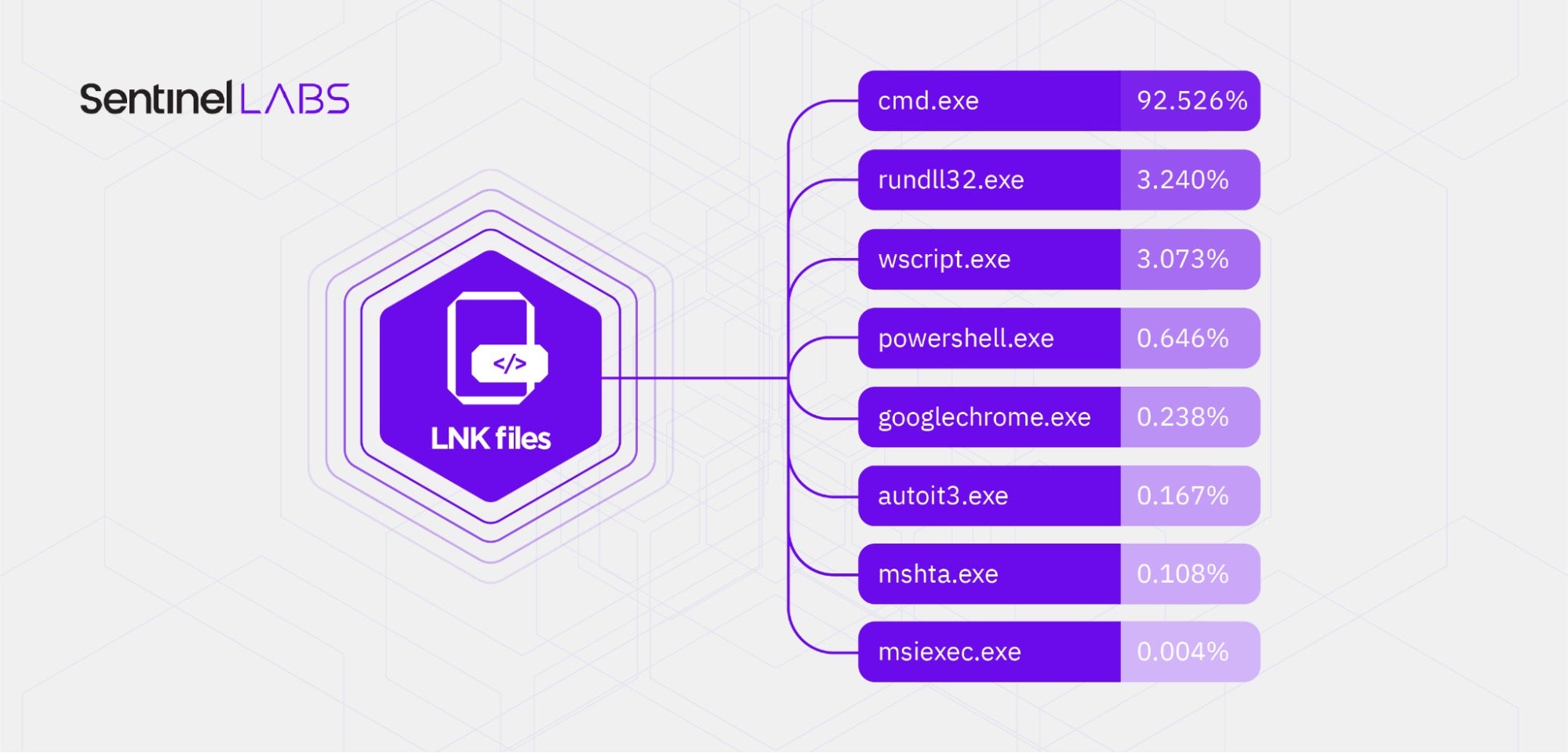
The shortcut targets are LOLbins and/or enable the execution of attacker-specified code and/or executables. We observed the following targets at the top of the list:
cmd.exe, the Windows command interpreter, which enables the execution of Windows commands and arbitrary executables.rundll32.exe, which enables the execution of arbitrary code in a Windows DLL.wscript.exe, a Windows script execution environment, which enables the execution of arbitrary script code.powershell.exe, the command interpreter of the PowerShell scripting engine.
Malicious shortcuts activate cmd.exe as the shortcut target to execute one or multiple Windows commands (typically implemented as executables that reside in the %SystemRoot%\System32 folder), and/or attacker-provided files:
- Files with the filename extension
.exe(.exe files) and of Windows executable file format. - Files with filename extensions different from
.exe(non-.exefiles) and of any file format, including the Windows executable format.
Malicious shortcuts execute multiple Windows commands and/or attacker-provided files through cmd.exe by specifying them as part of command statements that are chained with the & symbol. The chained command statements are part of the command line arguments of the shortcut target cmd.exe.
The malicious shortcuts we analyzed execute a variety of Windows commands through cmd.exe.
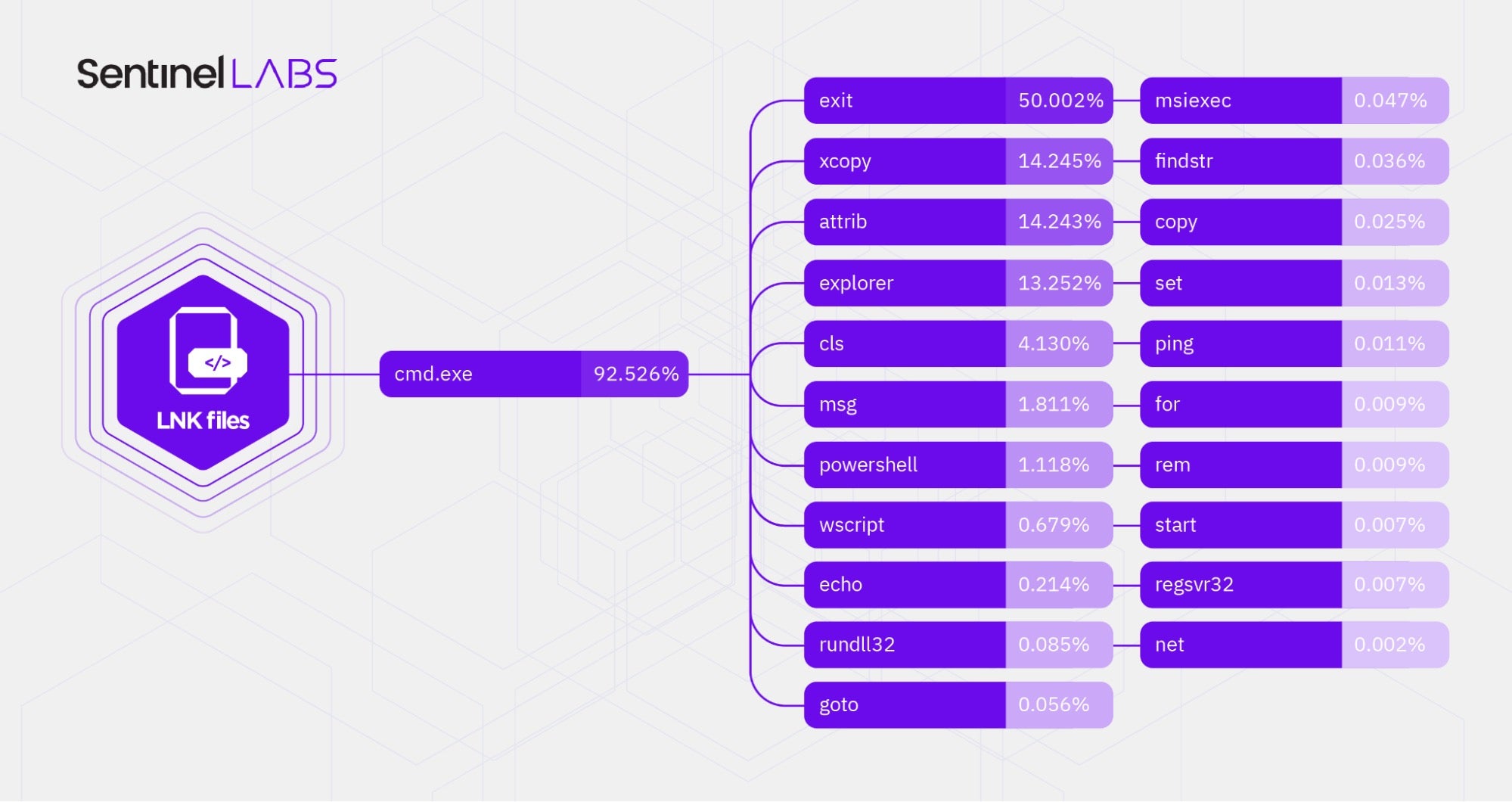
We categorize the commands as follows:
- Commands for command execution flow control, such as exit, goto, and for.
- Commands for file manipulation, such as xcopy, attrib, and copy.
- Commands that enable the execution of attacker-specified code and/or executables – LOLbins, such as explorer, powershell, wscript, rundll32, msiexec, start, and regsvr32.
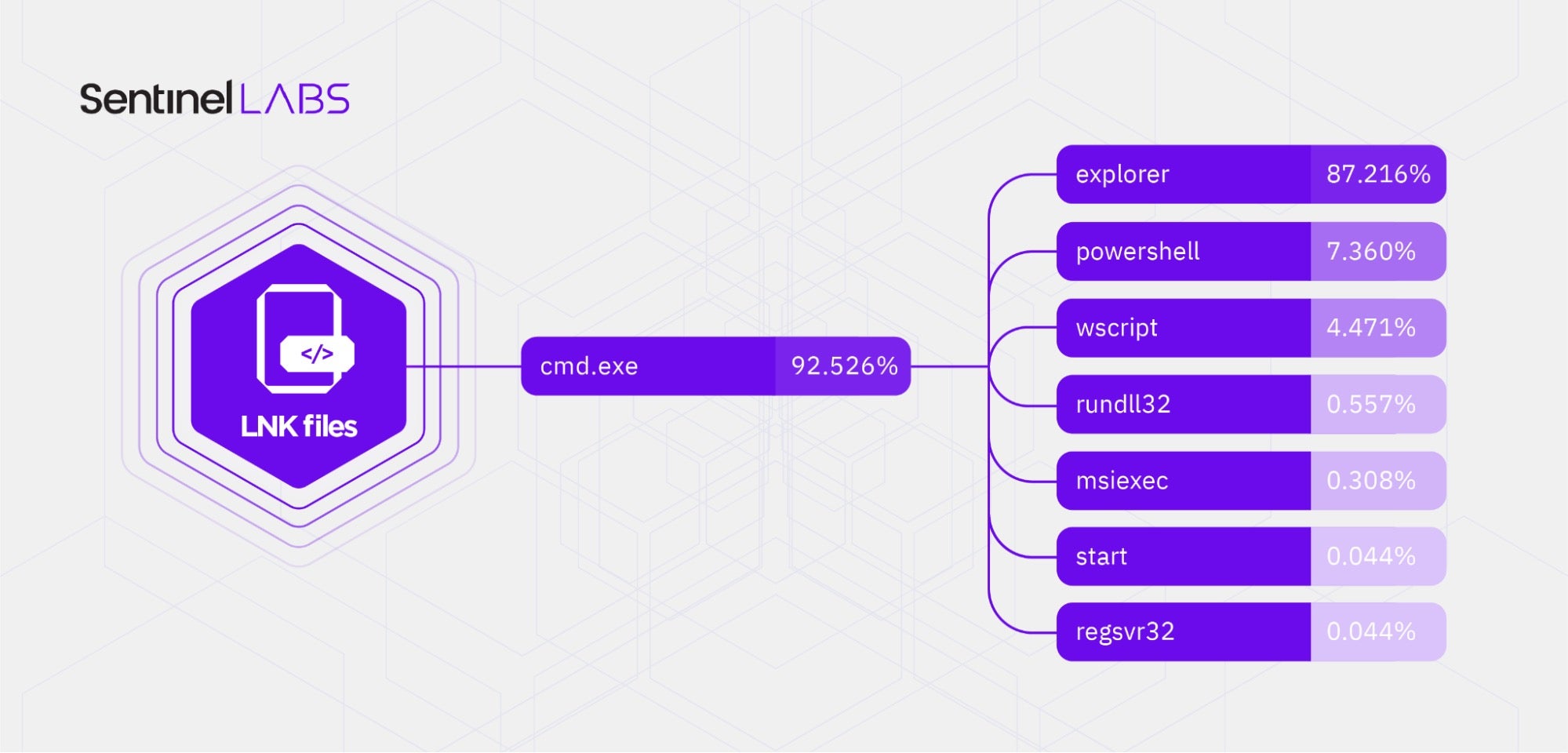
The prevalence of LOLbins in the set of the malicious shortcuts - Commands for information gathering, reconnaissance, and system configuration, such as findstr, set, ping, and net.
- Commands for messaging and controlling the command interpreter output, such as cls, msg, echo, and rem.
The majority of the filenames of the attacker-provided .exe files that the malicious shortcuts we analyzed execute through cmd.exe are random – 99.914% of the filenames are random and only 0.086% are non-random (comprehensible), such as streamer.exe, setup.exe, or windowsupdater.exe.
We grouped the malicious shortcuts that execute attacker-provided .exe files through cmd.exe into clusters according to the filenames of the .exe files. We observed that the .exe files with non-random filenames are executed by a small number of shortcut clusters with large population sizes, with an average of 1177 shortcuts. On the contrary, the .exe files with random filenames are executed by a large number of shortcut clusters with very small population sizes, the majority of which with no more than 3 shortcuts. This shows that defenders should consider highly suspicious shortcuts that execute .exe files with random filenames, while staying on top of .exe file naming trends in the threat landscape for better detection coverage.
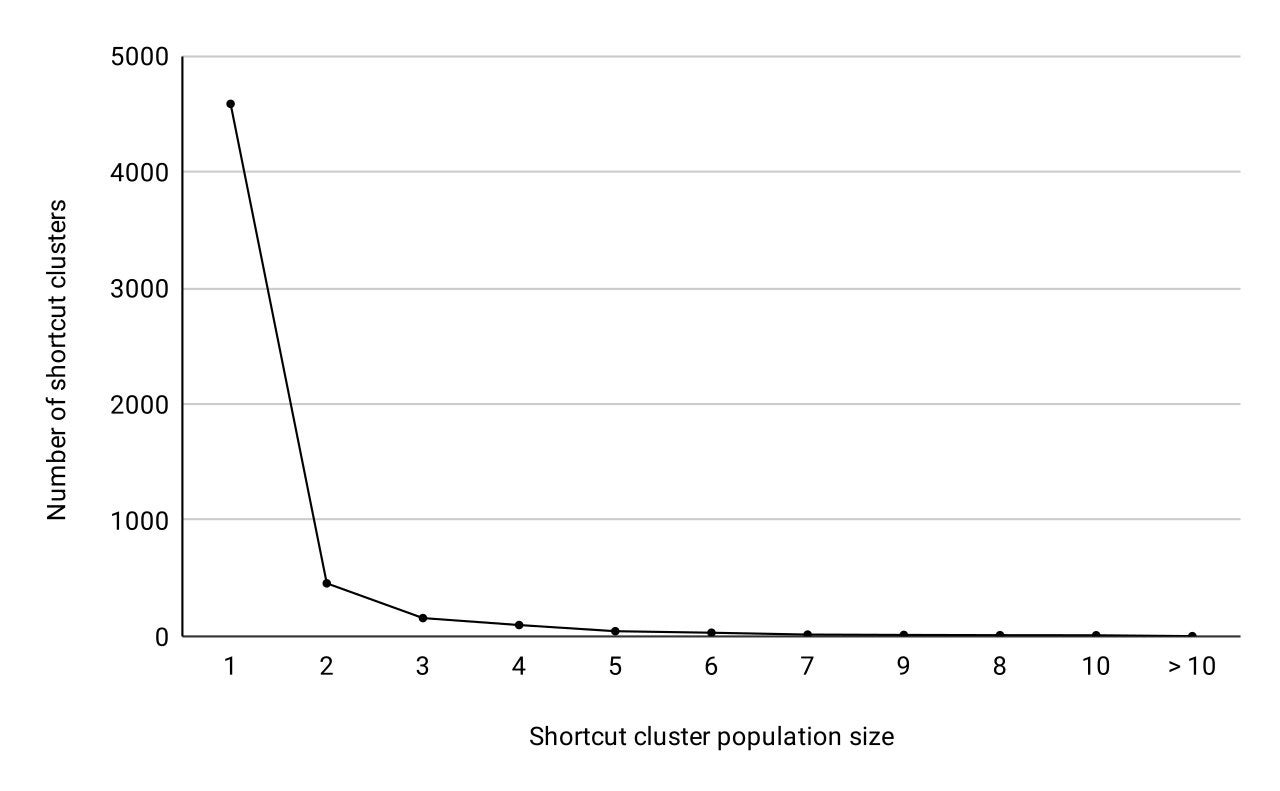
We observed a very diverse set of 253 different filename extensions of the attacker-provided non-.exe files that the malicious shortcuts we analyzed execute through cmd.exe.
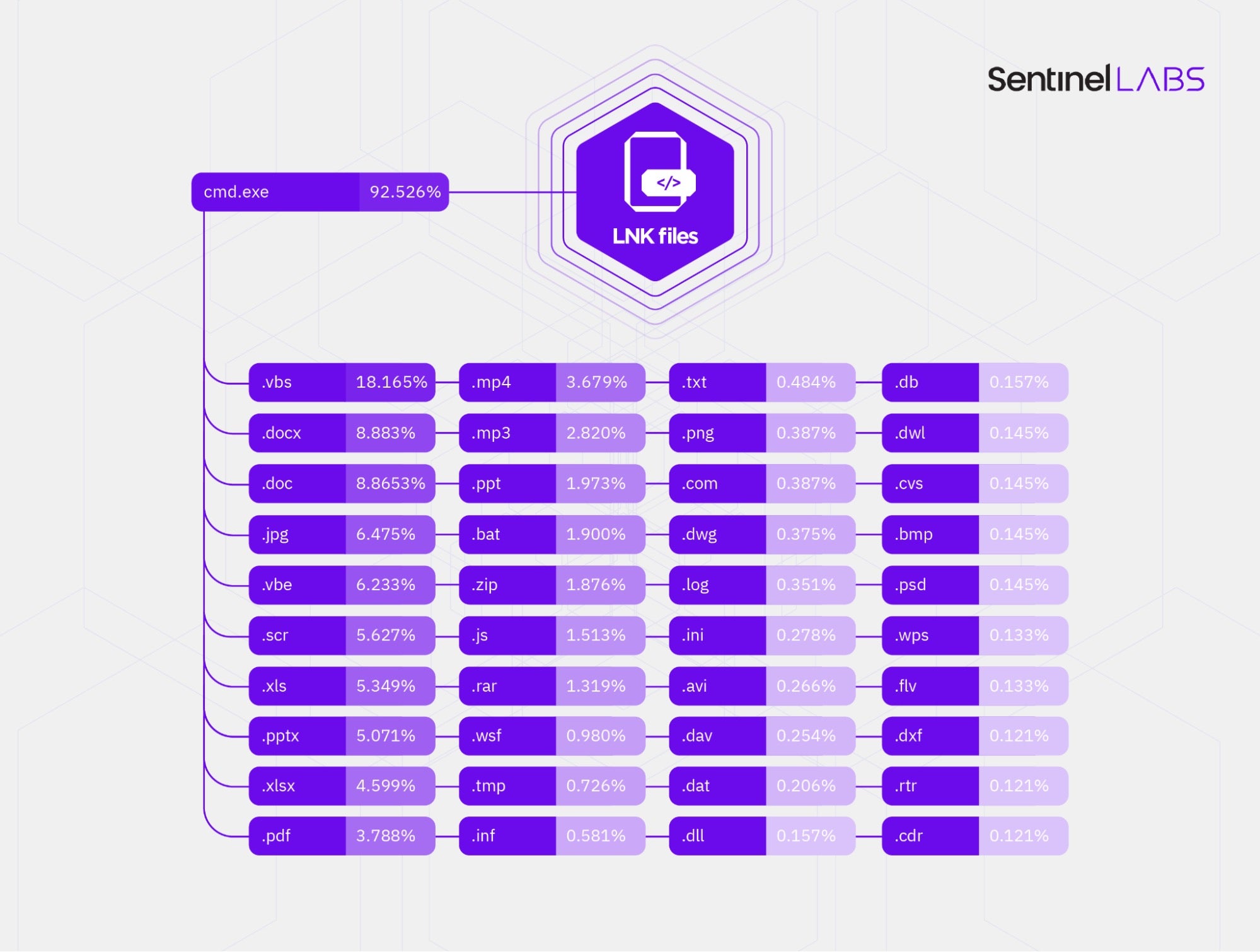
Considering filename extensions only, the malicious shortcuts executed:
- Script files, such as files with the filename extensions
.vbs,.vbe, and.js; - Executable files, such as files with the filename extensions
.scrand.dll; - Data files – files that store textual, audio, video, archive, and/or other arbitrary content, such as files with the filename extensions
.docx,.png.,.log., and.dat.
We observed that the filename extensions of the vast majority of the apparent data files, such as .docx or .avi, spoof filename extensions of executable or script files, such as .exe or .vbs, to masquerade executable or script files as files of other formats.
For approximately 0.5% of the malicious shortcuts we analyzed, the combined length of the filesystem path to the shortcut target and the command line arguments that the system specifies at target activation is greater than 260 characters. Visual inspection of the Properties > Shortcut > Target field of an LNK file in the Explorer utility, which displays the path to the shortcut target and any command line arguments, does not reveal anything beyond 260 characters. Attackers are known to abuse this for obfuscation – they craft LNK files such that command line arguments are padded with characters, such as newline or space, so that the combined length of the path to the shortcut target and the command line arguments significantly exceeds 260 characters.
We observed character padding mostly in shortcuts that targeted powershell.exe. In addition, we observed string concatenation and the use of the caret (^) symbol for target and/or command line argument obfuscation in approximately 2.5% of the samples.
How Does Windows Execute Shortcuts?
The user interface of the Windows operating system, a component referred to as the Windows Shell, manages and conceptually represents as objects entities that users interact with. Objects include entities that reside on the filesystem, such as files and folders, as well as other entities, such as networked computers. The Windows Shell structures these objects into a namespace – the Shell namespace.
When a user creates a shortcut to another object (also referred to as the shortcut target) using the Create shortcut command, the Windows Shell creates a Shell Link object and an LNK file – a file with the .lnk filename extension. An LNK file is in the binary Shell Link file format and stores information that Windows needs to access (activate) the shortcut target in data structures. This information includes:
- The filesystem path to the shortcut target, for example, the path relative to the location of the
LNKfile (in theRELATIVE_PATHstructure) and the absolute path (in theLinkTargetIDListstructure). - The parameters (command line arguments) that the system specifies at shortcut target activation (in the
COMMAND_LINE_ARGUMENTSstructure). - The filesystem path to the shortcut icon that the system displays for the
LNKfile in icon view (in theICON_LOCATIONstructure).
The figure below depicts the content of the malicious LNK file that we named malLNK.lnk (SHA-1 hash value: 5b241d50f1a662d69c96d824d7567d4503379c37). We displayed the content of malLNK.lnk using the LECmd LNK file parsing tool.
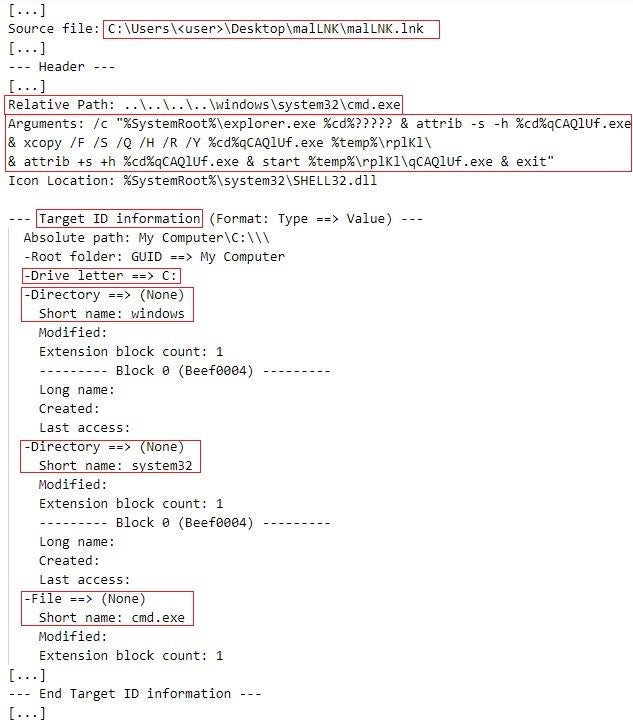
The shortcut target of malLNK.lnk is C:\Windows\System32\cmd.exe and the command line argument is:
/c "%SystemRoot%\explorer.exe %cd%新建文件夹 & attrib -s -h %cd%qCAQlUf.exe & xcopy /F /S /Q /H /R /Y %cd%qCAQlUf.exe %temp%\rplKl\ & attrib +s +h %cd%qCAQlUf.exe & start %temp%\rplKl\qCAQlUf.exe & exit"
In summary, the activated shortcut target uses the Explorer utility to execute an executable, manipulates the System and Hidden attributes of executables, copies an executable, and executes the copied executable.
The following figure depicts a simplified overview of the activities that the Windows operating system conducts to activate a shortcut target through an LNK file. We take malLNK.lnk as a running example.
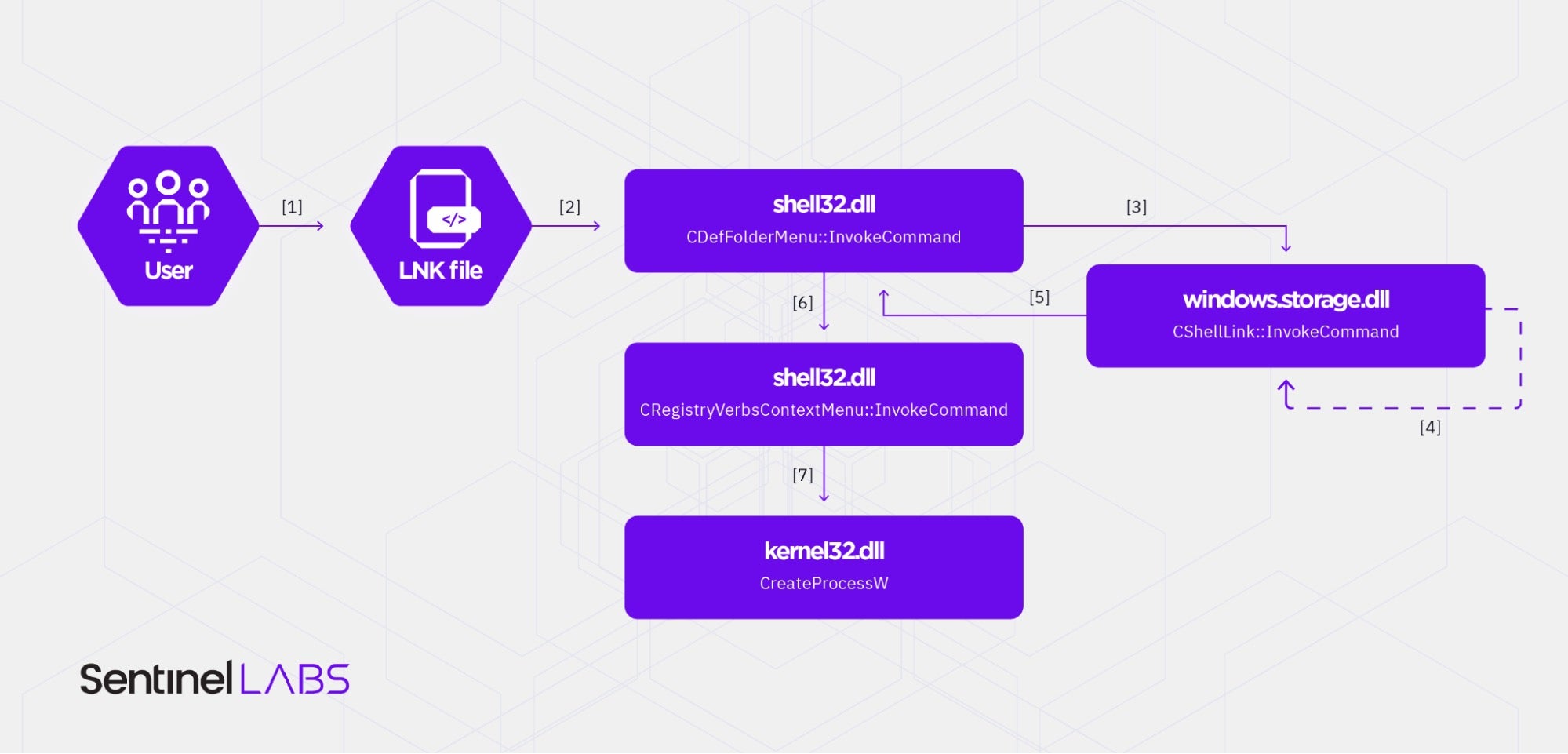
Windows handles shortcut target activation using implementations of the IContextMenu::InvokeCommand Windows Shell method. This function takes a single parameter of type CMINVOKECOMMANDINFO or CMINVOKECOMMANDINFOEX. The CMINVOKECOMMANDINFO(EX) data structure stores information about the command that the Windows Shell executes when a user triggers the execution of IContextMenu::InvokeCommand. In the context of shortcuts, the command is the shortcut target with any command line arguments.
The information that CMINVOKECOMMANDINFO(EX) stores includes the working directory at command execution (the lpDirectory(W) structure fields) and command parameters (the lpParameters(W) structure fields). In contrast to CMINVOKECOMMANDINFO,CMINVOKECOMMANDINFOEX allows for Unicode structure field values.
When a user double-clicks malLNK.lnk (label [1]), the system executes the CDefFolderMenu::InvokeCommand function (label [2]). CDefFolderMenu::InvokeCommand is implemented in the %SystemRoot%\System32\shell32.dll. This function populates a CMINVOKECOMMANDINFOEX structure and passes the execution flow to the CShellLink::InvokeCommand function with the populated CMINVOKECOMMANDINFOEX structure as the function’s parameter.
CShellLink::InvokeCommand is implemented in %SystemRoot%\System32\windows.storage.dll (label [3]). The CMINVOKECOMMANDINFOEX data structure that the CShellLink::InvokeCommand function takes as its parameter has only a few fields populated, for example, the mandatory cbSize field (specifies the size ofCMINVOKECOMMANDINFOEX in bytes) and lpDirectory(W).
The figure below depicts the content of the CMINVOKECOMMANDINFOEX structure that CShellLink::InvokeCommand takes as its parameter. malLNK.lnk resides in the C:\Users\<user>\Desktop\malLNK folder – this determines the values of the lpDirectory(W) fields.
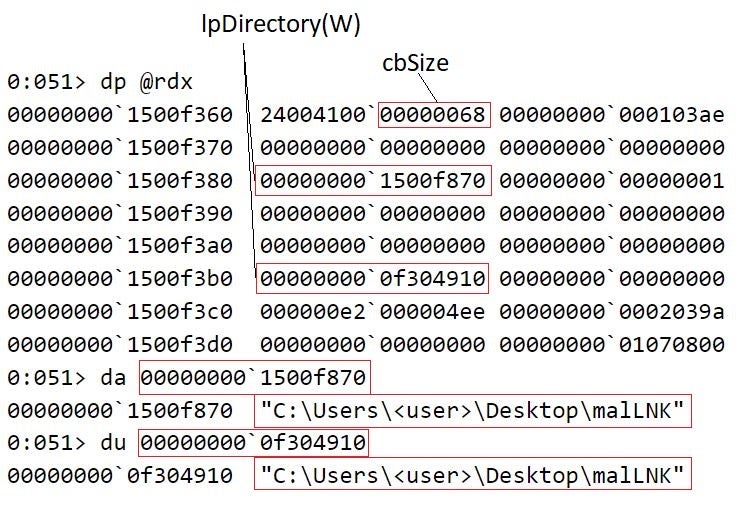
The CShellLink::InvokeCommand function conducts the central activities related to shortcut handling. This includes locating the shortcut target on the filesystem, expanding environment variables, and fully populating a CMINVOKECOMMANDINFOEX structure (label [4]). CShellLink::InvokeCommand passes the execution flow back to the CDefFolderMenu::InvokeCommand function with a fully populated CMINVOKECOMMANDINFOEX structure (label [5]). For example, the populated CMINVOKECOMMANDINFOEX structure stores the command parameter in the lpParameters(W) structure fields – this is the data in the COMMAND_LINE_ARGUMENTS structure that resides in malLNK.lnk.
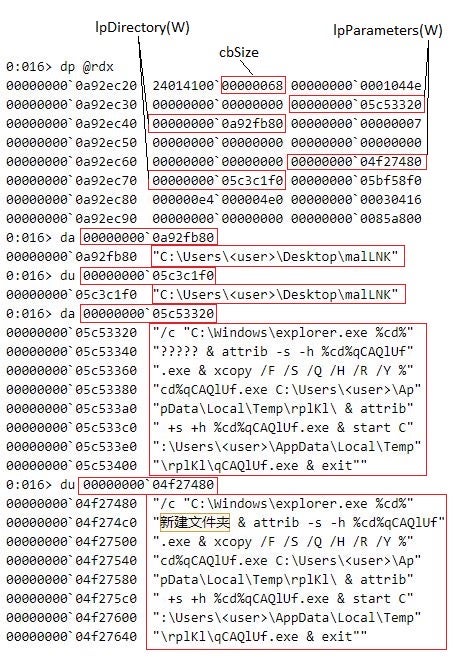
The CDefFolderMenu::InvokeCommand function then passes the execution flow to the CRegistryVerbsContextMenu::InvokeCommand function with the fully populated CMINVOKECOMMANDINFOEX structure as the function’s parameter (label [6]). CRegistryVerbsContextMenu::InvokeCommand is implemented in the shell32.dll DLL.
The invocation of CRegistryVerbsContextMenu::InvokeCommand leads to the creation of a new process by invoking the CreateProcessW function that is implemented in %SystemRoot%\System32\kernel32.dll (label [7]). The command line of this process is the shortcut target and the command line argument, as shown below.
C:\windows\system32\cmd.exe /c "%SystemRoot%\explorer.exe %cd%新建文件夹 & attrib -s -h %cd%qCAQlUf.exe & xcopy /F /S /Q /H /R /Y %cd%qCAQlUf.exe %temp%\rplKl\ & attrib +s +h %cd%qCAQlUf.exe & start %temp%\rplKl\qCAQlUf.exe & exit"
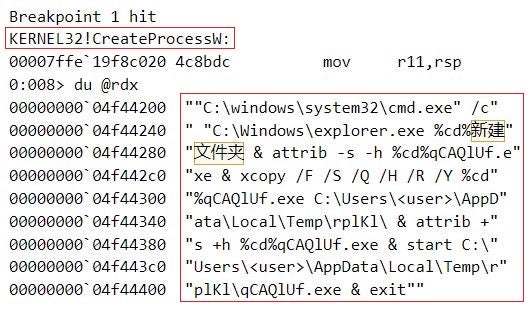
Recommendations for Investigators and Users
Investigators should consider highly suspicious any Windows shortcut (LNK file) that exhibits the following in the execution chain that originates from the shortcut:
- Execution of executables (including activation of shortcut targets) that are LOLbins and/or enable the execution of attacker-specified code and/or executables. We observed the following such executables to be among the most prevalent in the set of malicious shortcuts we analyzed:
explorer.exe,powershell.exe, andwscript.exe. - Execution of files with a filename extension different from
.exe(non-.exefiles) throughcmd.exeas the shortcut target. We observed 253 different extensions of the non-.exefiles that the malicious shortcuts we analyzed execute. The majority of these non-.exefiles are files that store executable code (for example, Windows executables or script files) masquerading as files of other formats, such as audio or video files. - Execution of files with the
.exeextension and random filenames throughcmd.exeas the shortcut target. For.exefiles with non-random (comprehensible) filenames, investigators should stay on top of.exefile naming trends in the threat landscape for better detection coverage.
Users should stay vigilant against phishing attacks and refrain from executing attached files that originate from unknown sources. Threat actors are distributing malicious LNK files through phishing emails at a mass scale and there is a substantial number of active widespread attack campaigns that involve malicious shortcuts. The malicious LNK files often come with misleading filenames and icons masquerading as important documents or critical software to lure users into activating the shortcuts.




